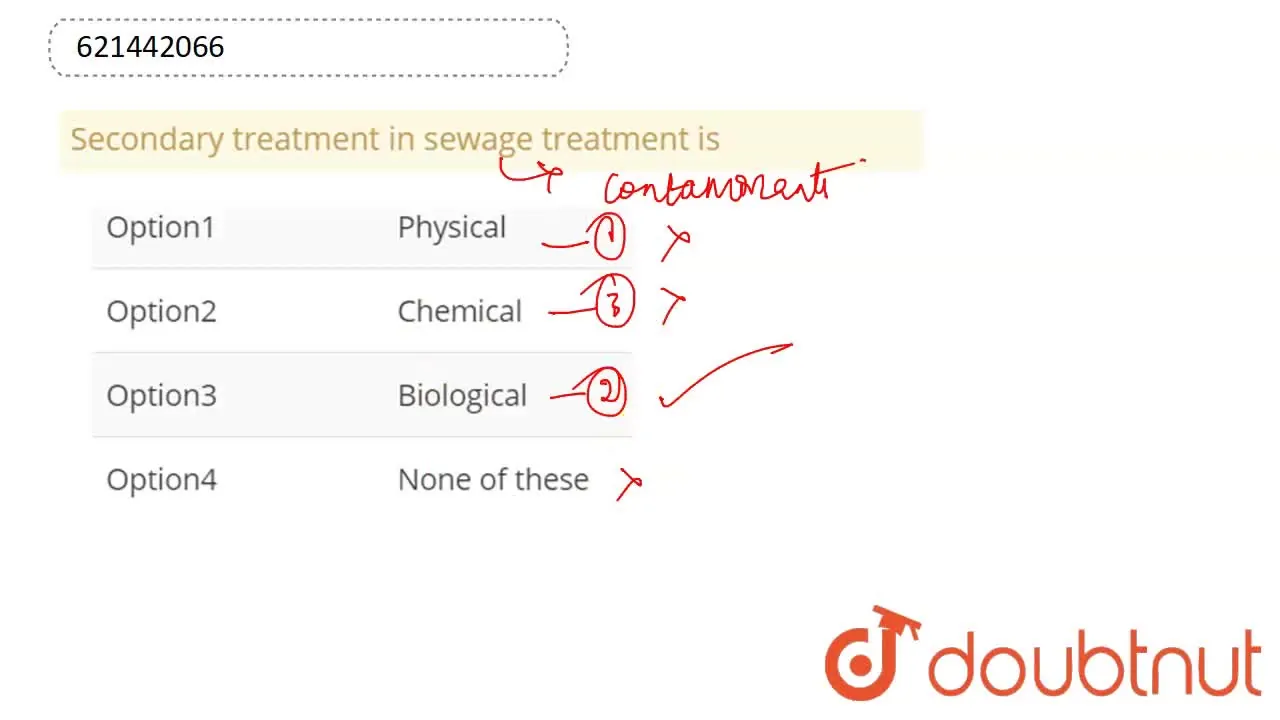Secondary treatment in sewage treatment isSolution in Telugu
Municipal waste-water is also called sewage. It contains large amount of organic matter and microbes, many of which are pathogenic. This sewage cannot be discharged into natural water bodies before disposal, sewage is treated in sewage treatment plants to make it less polluting treatment of waste water is done by heterotrophic microbes naturally present in the sewage. this treatment is carried out in two stages.
(1). Primary treatment : It involves physical removal of particles from the sewage through filteration and sedimentationi. floating debris is removed by seanential filteration. then the grit (soil & small pebbles) is removed by sedimentations.
All solids that settle form the primary sludge and the supernatant forms the effluent the effluent is taken for the secondary treatment.
(2). Secondary treatment or Biological treatment : The primary effluent is taken into large tanks where it is constantly agitated mechanically and air is pumped into it. this allows vigorous growth of aerobic microbes into flocs. while growing, these microbes consume the major of the orgnanic matter in the effluent. this significantly reduces the BOD of the effluent. the sewage water is treated till the BOD is reduced. now the effluent is passed into a settling tank where the bacterial flocs are allowed to sediment. this sediment is called activated sludge. this activated sludge is pumped into aeration tanks (small amount) and anaerobic sludge digesters (large amount). here other kind of bacteria which grow anaerobically, digest the bacteria & fungi in the sludge. during this digestion bacteria produces a mixture of gases such as methane, H2S&CO2. The effluent from the secondary treatment plant is released into natural water bodies like rivers and streams.
Related Playlists
- BOOK - VIKRAM PUBLICATION ( ANDHRA PUBLICATION)CHAPTER - MICROBES IN HUMAN WELFAREEXERCISE - EXERCISE13videos
MICROBES IN HUMAN WELFARE
- BOOK - VIKRAM PUBLICATION ( ANDHRA PUBLICATION)CHAPTER - MICROBES IN HUMAN WELFAREEXERCISE - SHORT ANSWER QUESTIONS3videos
MICROBES IN HUMAN WELFARE
- BOOK - VIKRAM PUBLICATION ( ANDHRA PUBLICATION)CHAPTER - MARCH - 2017 (TELANGANA)EXERCISE - SECTION C3videos
MARCH - 2017 (TELANGANA)
- BOOK - VIKRAM PUBLICATION ( ANDHRA PUBLICATION)CHAPTER - MINERAL NUTRITION EXERCISE - EXERCISES24videos
MINERAL NUTRITION
Similar Questions
Bacteria cannot be seen with the naked eyes, but these can be seen with the help of a microscope. If you have to carry a sample from your home to your biology laboratory to demonstrate the presence of microbes under a microscope, which sample would you carry and why?
02:44View SolutionMycorrhizal hyphae prove useful to the plant by
02:38View SolutionIn Krebs cycle
03:07View SolutionHydroponics help for
03:17View SolutionSecondary sewage treatment is mainly a
01:28View SolutionSecondary treatment or biological treatment of waste or sewage is done by the :-
03:50View SolutionSecondary treatment of sewage
01:24View SolutionSecondary sewage treatment is mainly a
02:11View SolutionSecondary treatment in sewage treatment is
01:35View SolutionSecondary treatment of sewage
01:24View SolutionSecondary sewage treatment is mainly a:
05:07View SolutionSecondary sewage treatment is mainly
03:59View Solutionद्वितीयक वाहितमल उपचार मुख्य रूप से है:
02:30View SolutionSecondary sewage treatment is mainly a:
02:21View SolutionSecondary sewage treatment is mainly a
02:49View SolutionWhat is "Secondary treatment" of sewage?
04:18View Solution


